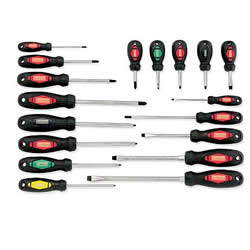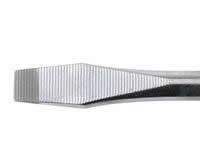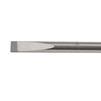
Figure 1 - Set of screwdrivers
Screwdrivers (Figure 1) are probably the most misused tool in any handyman’s tool chest. Screwdrivers are used as chisels, pry bars, wedges, and leveling devices.
Most home improvement and repair projects, whether they are easy or difficult, require the use of a screwdriver, and I am often amazed when the well equiped home handyman pulls out screwdrivers purchased at a dollar store.
Although there are a dozen different screwdriver tip styles, the home handyman generally only needs to be concerned with two tip styles – slot, and Phillips. In Canada Robertson screwdrivers are more common than Phillips. Most of the other tip styles are used in mechanical applications such as vehicle assembly and electronics.

Figure 2 - Slot screw head

Figure 3 - Phillips screw head

Figure 4 - Robertson screw head
Screwdriver tips are most often damaged by using a screwdriver tip that is smaller than the socket in the screw head, other than damage caused by using the screwdriver for a purpose it was not designed for.
The tip of the screwdriver should fit snuggly in the socket of the screw, and in the case of a slot tipped screwdriver, should be approximately the same width as the diameter of the screw head. If you are using screws that have a tapered head for countersink applications, it is important that the tip of the screwdriver does not exceed the width of the screw head. A screwdriver with a tip that exceeds the width of the countersink screw head will damage the wood as the screw is inserted.
The two most common types of screwdrivers are:
- Slot (Figure 2)
- Phillips (Figure 3)
- Robertson (Figure 4)
In Canada there is a third common screwdriver:
Purchasing Screwdrivers:
Having the correct size screwdriver for the task at hand prevents damage to the screw head, makes inserting the screw easier and avoids damage to the screwdriver. I recommend that instead of buying a set of screwdrivers, and ending up with using a screwdriver that is "close" to the correct size, that you purchase screwdrivers as they are needed to meet a specific task requirement. Before long you will have a collection of screwdrivers that suits your needs and fastening requirements.
Inexpensive screwdrivers do not last. Quality screwdrivers will come with a lifetime guarantee that provides for replacement if the tip, shank or handle breaks.
Do not buy screwdrivers that have chrome plated shanks and tips as the plating will wear off, and in many cases chip off, over time.
Quality screwdrivers should have hardened tips. A screwdriver with a hardened tip usually has the tip blackened for identification.
Hold the screwdriver in your hand, it should feel comfortable. Fancy shaped grips can lead to blisters, if you have a large quantity of screws to insert.
Selection of quality screwdrivers.
Screwdriver Sizes:

Figure 5 - Standard tip screwdriver

Figure 6 - Cabinet tip screwdriver
Besides quality and comfort there are three things to consider when purchasing screwdrivers.
Size of the tip:
Slot:
With slot screwdrivers there are hundreds of blade sizes, because there is no industry standard. However the most common are 1/8", 1/4", 3/16", 5/16", and 3/8" wide blades.
There are two primary different screwdriver tip and shaft shapes. General screwdrivers have a tip that is shaped in the form of a wedge, as shown in Figure 5. Cabinet screwdrivers have a tip that is the same width as the diameter of the shaft, as shown in Figure 6.
Phillips:
The most common Phillips screwdrivers for the home handyman are sizes #1 to #3 where each number matches a screw size diameter. The most common for home applications is a #2 Phillips. If you are involved in a lot of outdoor woodworking projects you may find that having a #3 and #4 Phillips screwdriver to be beneficial.
Note: There are exceptions to every rule and it is possible to find a Phillips screw that has a smaller socket size than would be indicated by the diameter of the screw.
Robertson:
Five sizes are available but for most home handymen two sizes, green and red are the most common. The sizes correspond to the diameter of the screw as shown in Table 1.
Table 1 - Robertson Screwdriver Sizes |
||||
Screw Size # |
Handle Color |
Screwdriver Size # |
Screw Size Diameter Inches |
|
1, 2 |
Orange |
00 |
1/16 |
|
3, 4 |
Yellow |
0 |
3/32 |
|
5, 6, 7 |
Green |
1 |
7/64 |
|
8, 9, 10 |
Red |
2 |
1/8 |
|
12+ |
Black |
3 |
3/16 |
|
